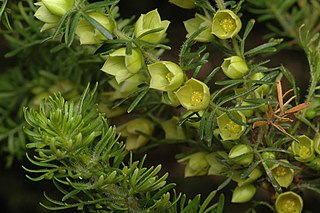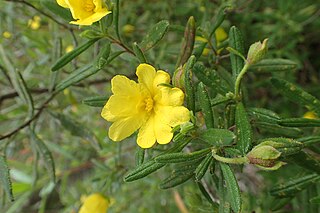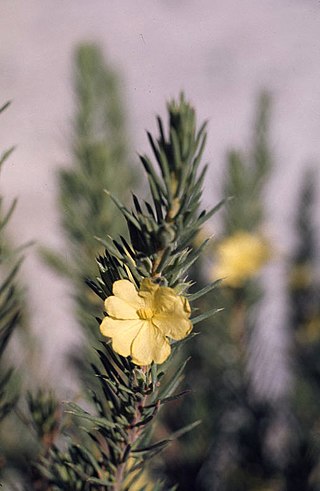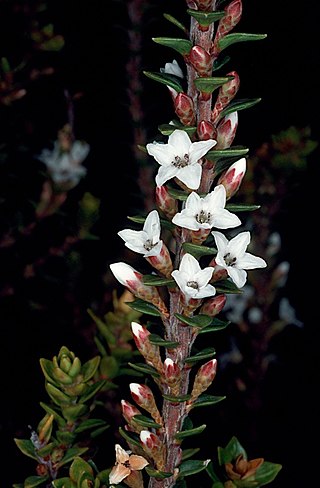
Hibbertia sericea, commonly known as silky guinea-flower, is a species of flowering plant in the family Dilleniaceae and is endemic to south-eastern Australia. It is an erect or spreading shrub with softly-hairy branches, elliptic to egg-shaped leaves with the narrower end towards the base, and yellow flowers with eight to fourteen stamens in a cluster on one side of two hairy carpels.

Pultenaea juniperina, commonly known as prickly bush-pea or prickly beauty is a species of flowering plant in the family Fabaceae and is endemic to south-eastern Australia. It is an erect, spiky shrub with hairy stems, linear to narrow elliptic leaves with stipules at the base, and yellow-orange and red flowers.

Hibbertia empetrifolia, commonly known as trailing guinea-flower, is a species of flowering plant in the family Dilleniaceae and is endemic to south-eastern Australia. It is a low-lying to spreading shrub with wiry stems, oblong to lance-shaped leaves with the narrower end towards the base, and pale to bright yellow flowers arranged on the ends of branchlets, with five to nine stamens arranged on one side of the two carpels.

Hibbertia stricta is a species of flowering plant in the family Dilleniaceae and is endemic to New South Wales. It is a small, usually upright shrub with hairy foliage, linear leaves and yellow flowers with six or seven stamens arranged around two woolly-hairy carpels.

Hibbertia hermanniifolia is a species of flowering plant in the family Dilleniaceae and is endemic to eastern Australia. It is an erect shrub with spatula-shaped to wedge-shaped leaves and yellow flowers arranged singly in leaf axils, with ten to fifteen stamens arranged around two hairy carpels.

Boronia tetrandra, commonly known as yellow boronia, is a plant in the citrus family, Rutaceae and is endemic to Western Australia. It is a spreading or erect shrub with hairy stems, pinnate leaves and greenish cream to yellow or reddish brown, cup-shaped, four-petalled flowers.
Hibbertia cactifolia is a species of flowering plant in the family Dilleniaceae and is endemic to the Arnhem Land escarpment. It is a multi-stemmed shrublet with hairy foliage, oblong to elliptic leaves and yellow flowers arranged singly in leaf axils, with twenty-six to twenty-eight stamens arranged in groups around the two carpels.
Hibbertia circularis is a species of flowering plant in the family Dilleniaceae and is endemic to the northern part of the Northern Territory. It is a perennial herb with prostrate, trailing branches, elliptic to more or less round leaves, and yellow flowers arranged in leaf axils, with thirty stamens arranged in groups around the two carpels.
Hibbertia cistifolia is a species of flowering plant in the family Dilleniaceae and is endemic to northern Australia. It is a prostrate to low-lying sub-shrub with trailing, wiry stems, hairy foliage, oblong to elliptic leaves and yellow flowers arranged in leaf axils, with forty to fifty-eight stamens arranged around the two carpels.
Hibbertia depilipes is a species of flowering plant in the family Dilleniaceae and is endemic to the far south-west of Western Australia. It is usually a sprawling shrub with scattered linear leaves and yellow flowers arranged singly in leaf axils usually with ten stamens all on one side of the two carpels.

Hibbertia furfuracea is a species of flowering plant in the family Dilleniaceae and is endemic to near-coastal areas of south-western Western Australia. It is an erect shrub with narrow egg-shaped leaves with the narrower end towards the base, and yellow flowers borne in upper leaf axils, with ten to twelve stamens all on one side of two carpels.

Hibbertia hibbertioides is a species of flowering plant in the family Dilleniaceae and is endemic to near-coastal areas of south-western Western Australia. It is a small, prostrate or sprawling shrub with crowded, linear cylindrical leaves and yellow flowers with usually eleven stamens arranged in groups around three carpels.
Hibbertia hirsuta is a species of flowering plant in the family Dilleniaceae and is endemic to southern Australia. It is a small, slender, prostrate shrub with sparsely hairy foliage, narrow elliptic leaves and small yellow flowers with a single petal, usually only a single stamen and two carpels.

Hibbertia huegelii is a species of flowering plant in the family Dilleniaceae and is endemic to the south-west of Western Australia. It is an erect, spreading or prostrate shrub with hairy branchlets, linear leaves and yellow flowers arranged singly in leaf axils on the ends of shoots, with fifteen to twenty-five stamens in bundles around the four or five carpels.
Hibbertia incompta is a species of flowering plant in the family Dilleniaceae and is endemic to the Northern Territory. It is a weakly stemmed, often prostrate shrublet with hairy foliage, linear to elliptic leaves, and yellow flowers arranged in leaf axils with 45 to 60 stamens arranged in groups around the two or three carpels.
Hibbertia intermedia is a species of flowering plant in the family Dilleniaceae and is endemic to New South Wales. It is a small shrublet with linear to narrow oblong leaves and yellow flowers usually with seven to nine stamens arranged in a single cluster.

Hibbertia mucronata is a species of flowering plant in the family Dilleniaceae and is endemic to the south of Western Australia. It is an erect shrub with hairy branches, crowded, thick, tapering linear leaves ending in a sharp point, and golden yellow flowers with five stamens fused at their bases, all on one side of two densely hairy carpels.

Hibbertia procumbens, commonly known as spreading guinea flower, is a species of flowering plant in the family Dilleniaceae and is endemic to south-eastern Australia. It is a prostrate, often mat-forming shrub with more or less glabrous stems, linear to narrow lance-shaped leaves with the narrower end towards the base, and yellow flowers with eighteen to twenty-five stamens arranged in groups around usually four glabrous carpels.
Hibbertia verrucosa is a species of flowering plant in the family Dilleniaceae and is endemic to the south-west of Western Australia. It is a shrub with scattered, densely hairy, narrowly rectangular leaves and yellow flowers usually with ten stamens fused at the bases, all on one side of two densely softly-hairy carpels.

Epacris myrtifolia is a species of flowering plant in the heath family Ericaceae and is endemic to Tasmania. It is an erect shrub that typically grows to a height of 15–50 cm (5.9–19.7 in). Its leaves are thick, crowded, egg-shaped with a small, blunt point on the tip, and 4.2–8.5 mm (0.17–0.33 in) long. The flowers are arranged singly in a few upper leaf axils with many leathery bracts at the base. The sepals are leathery, about 4.2 mm (0.17 in) long, the petal tube slightly shorter than the sepals with lobes about the same length, the anthers protruding slightly from the petal tube.












